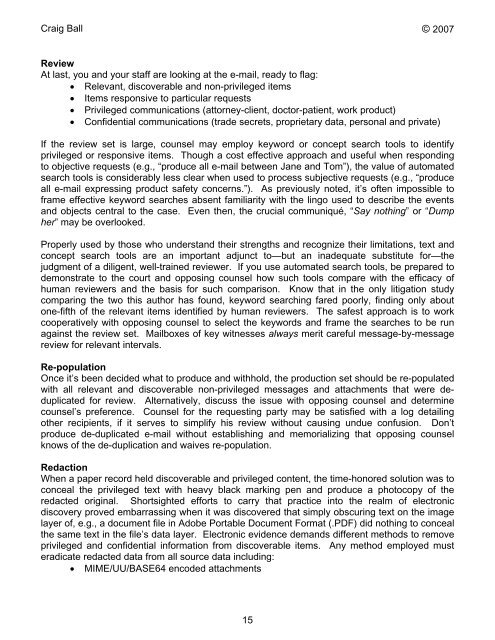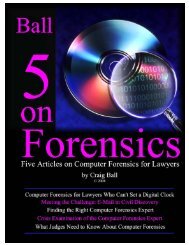Six Articles on Electronic - Craig Ball
Six Articles on Electronic - Craig Ball
Six Articles on Electronic - Craig Ball
You also want an ePaper? Increase the reach of your titles
YUMPU automatically turns print PDFs into web optimized ePapers that Google loves.
<strong>Craig</strong> <strong>Ball</strong> © 2007<br />
Review<br />
At last, you and your staff are looking at the e-mail, ready to flag:<br />
• Relevant, discoverable and n<strong>on</strong>-privileged items<br />
• Items resp<strong>on</strong>sive to particular requests<br />
• Privileged communicati<strong>on</strong>s (attorney-client, doctor-patient, work product)<br />
• C<strong>on</strong>fidential communicati<strong>on</strong>s (trade secrets, proprietary data, pers<strong>on</strong>al and private)<br />
If the review set is large, counsel may employ keyword or c<strong>on</strong>cept search tools to identify<br />
privileged or resp<strong>on</strong>sive items. Though a cost effective approach and useful when resp<strong>on</strong>ding<br />
to objective requests (e.g., “produce all e-mail between Jane and Tom”), the value of automated<br />
search tools is c<strong>on</strong>siderably less clear when used to process subjective requests (e.g., “produce<br />
all e-mail expressing product safety c<strong>on</strong>cerns.”). As previously noted, it’s often impossible to<br />
frame effective keyword searches absent familiarity with the lingo used to describe the events<br />
and objects central to the case. Even then, the crucial communiqué, “Say nothing” or “Dump<br />
her” may be overlooked.<br />
Properly used by those who understand their strengths and recognize their limitati<strong>on</strong>s, text and<br />
c<strong>on</strong>cept search tools are an important adjunct to—but an inadequate substitute for—the<br />
judgment of a diligent, well-trained reviewer. If you use automated search tools, be prepared to<br />
dem<strong>on</strong>strate to the court and opposing counsel how such tools compare with the efficacy of<br />
human reviewers and the basis for such comparis<strong>on</strong>. Know that in the <strong>on</strong>ly litigati<strong>on</strong> study<br />
comparing the two this author has found, keyword searching fared poorly, finding <strong>on</strong>ly about<br />
<strong>on</strong>e-fifth of the relevant items identified by human reviewers. The safest approach is to work<br />
cooperatively with opposing counsel to select the keywords and frame the searches to be run<br />
against the review set. Mailboxes of key witnesses always merit careful message-by-message<br />
review for relevant intervals.<br />
Re-populati<strong>on</strong><br />
Once it’s been decided what to produce and withhold, the producti<strong>on</strong> set should be re-populated<br />
with all relevant and discoverable n<strong>on</strong>-privileged messages and attachments that were deduplicated<br />
for review. Alternatively, discuss the issue with opposing counsel and determine<br />
counsel’s preference. Counsel for the requesting party may be satisfied with a log detailing<br />
other recipients, if it serves to simplify his review without causing undue c<strong>on</strong>fusi<strong>on</strong>. D<strong>on</strong>’t<br />
produce de-duplicated e-mail without establishing and memorializing that opposing counsel<br />
knows of the de-duplicati<strong>on</strong> and waives re-populati<strong>on</strong>.<br />
Redacti<strong>on</strong><br />
When a paper record held discoverable and privileged c<strong>on</strong>tent, the time-h<strong>on</strong>ored soluti<strong>on</strong> was to<br />
c<strong>on</strong>ceal the privileged text with heavy black marking pen and produce a photocopy of the<br />
redacted original. Shortsighted efforts to carry that practice into the realm of electr<strong>on</strong>ic<br />
discovery proved embarrassing when it was discovered that simply obscuring text <strong>on</strong> the image<br />
layer of, e.g., a document file in Adobe Portable Document Format (.PDF) did nothing to c<strong>on</strong>ceal<br />
the same text in the file’s data layer. Electr<strong>on</strong>ic evidence demands different methods to remove<br />
privileged and c<strong>on</strong>fidential informati<strong>on</strong> from discoverable items. Any method employed must<br />
eradicate redacted data from all source data including:<br />
• MIME/UU/BASE64 encoded attachments<br />
15













